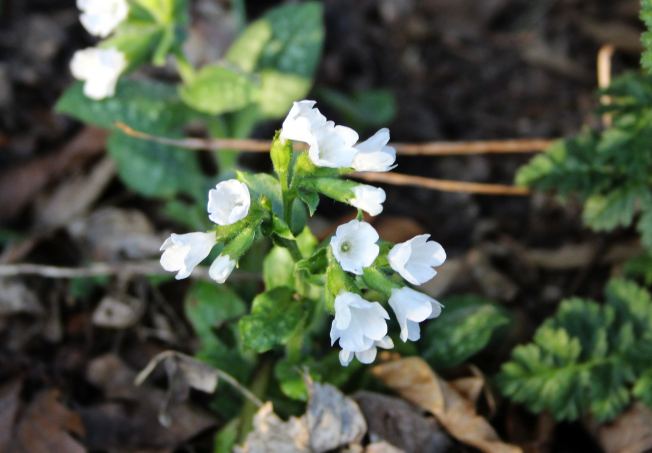My first (happy) meeting with Pulmonaria flowers was in a car park in Blakeney, North Norfolk, UK. The whole of the front of the hotel we were staying at was planted with the pink and blue beauties and the bees were having a real party!
Since then I have been smitten.
Over the last few years I have collected several which I’d like to show you… some remain unidentified, but the more recent ones have been carefully labelled. One of these was the first to open in my garden this spring; “Sissinghurst White”. It has freckly, silvery green leaves and is a small and upright specimen. It has been flowering for about 3 weeks now.
And here a visitor is looking for some shade beneath it…
The next to open was one of the unidentified ones picked up from a garden centre, helpfully labelled “Pulmonaria”! It is situated in a very dry spot in full sun, but seeded itself there and seems very happy.
The tiny flowers change colour as they age, not fading but often becoming more vibrant. And the foliage, in various shades of green, both with and without silvery freckling, is an attractive extra, especially before and after the flowers appear. I have been very impressed with the plain-leafed “Azurea” below, which has flowered well and put on a lot of new growth.
A mild winter seems to have helped them all, and I will have to make sure they get some water in the summer occasionally too. In an extremely dry and hot garden like mine in summer it is a good idea to find spots where other plants provide shade later in the year.
I remarked a couple of weeks ago that the P. angustifolia “Azurea” is the only one I had seen with plain, unfreckled leaves…. well, I hadn’t been looking very closely! I have since found two others in my garden that are not spotted; Pulmonaria rubra ‘Redstart’ was a new addition to my garden last autumn and is doing well. Its flowers really are red, with no hint of pink, and the plain pale green leaves are not as elongated as most.
I have really fallen for Rubra!
The other plain-leafed one is possibly a hybrid as I have no recollection of planting this one! It is very delicate and has lovely pale pink flowers…
Another new one to my garden this year is “Trevi Fountain”. It has the same deep azure blue as “Azurea”, but with freckled leaves…
The last two are very similar: Dora Bielefeld, with pale geen freckled leaves and pinkish blue flowers…
… and “Wuppertal” with slightly darker green speckled foliage…
Pulmonaria should have a much prettier name; something evoking images of fairies and petticoats, candy and pearls. Just recently Steve at Portraits of Wildflowers found some more common names for me from Wikipedia, one of which I found quite cute: “Spotted Dog“. Still not quite fitting I feel, but fun!
Some other common names are, apparently, soldiers and sailors (the two hues of colour on each flower reflect the uniform colours), Joseph and Mary, Jerusalem cowslip, oak lungs, spotted comfrey, and Bethlehem sage. Some German common names include Hansel and Gretel, Adam and Eve, blue cowslip, deer cabbage (Hirschkohl), and baggy trousers (Schlotterhose)….
Which name do you think suits them best?
Do you grow Pulmonarias? Please share your photos too!
Links:

















